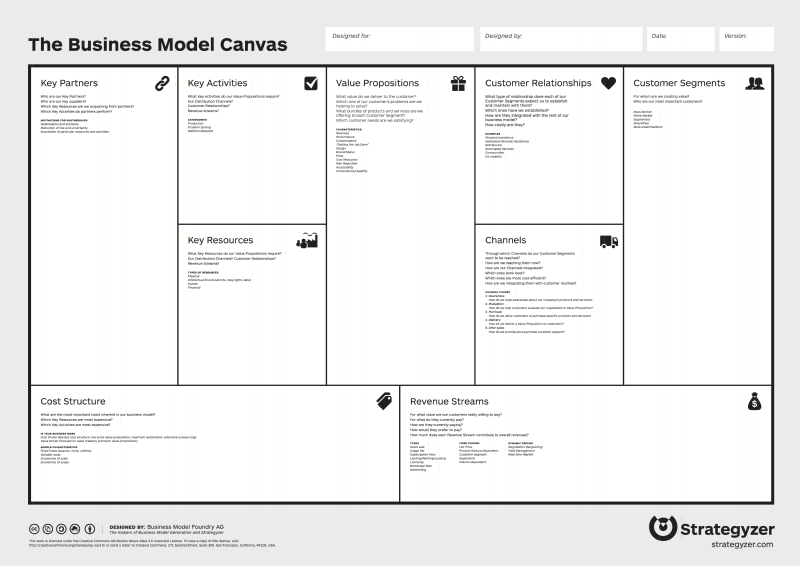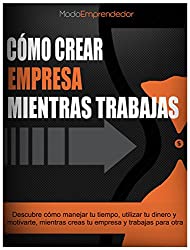
It has been proven that traditional business models are not adequate for a startup. Since a startup is totally different from a fully constituted company. However, starting a business without a plan would be sure to fail. Every great company starts with a plan, with goals and methods to achieve them. That is why we present you the Canvas business model.
Also read: Difference between a startup and a small business
A business plan at this stage is a good task to learn about the industry, competitors, and other related businesses. However, it doesn’t really meet the goal of a startup: which is to create a business model.
A startup doesn’t even know who its customers are or what its product should be like.
But, if we don’t start with the plan, what should we do to develop the business model?
Alexander Osterwalder, co-founder of strategyzer.com and author of the book Business Model Generation, has developed the Business Model Canvas. Which has been used by companies such as Coca Cola, General Electric and Lego; to test, build and manage your new business models.
What is the Canvas business model
As Osterwalder explains, the Business Model Canvas is a visual template that allows you to create a common language to describe, design, challenge, reinvent, and drive your business model.
The Canvas business model gives you the possibility to create the same structure of a business plan; but without the need for improvisation and the overload of information that writing it entails.
All this in a simple box. Easy to understand and above all easy to explain.
What is the structure of the Canvas business model.
The Canvas Model is structured through these 9 elements:
- Customer segments: Who are the people for whom your company will create value? I mean, who exactly are your customers?
- Relationship with customers: What kind of relationship do you have with your customers? How do you interact with them from the first contact until after the sale is made?
- Channels: Through which means are you interacting with your customers to deliver value to them? By what means is it done: web, telephone, personal?
- Value proposal: What are the products and/or services that you offer to create value for your customers? What exactly does your company sell?
- Key Activities: What are the activities that you must carry out in an exemplary manner to deliver value to your customers? What must you do yes or yes so that your company works perfectly?
- Key Resources: What is the infrastructure you need to create and deliver value? What are the assets that are essential in your business model?
- Key partners: Who can help you leverage your business model? Remember that you may not be able to carry out all the key activities on your own.
- Cost structure: What are the main costs involved in carrying out your activities? How are these costs related to income?
- Income Source: How and through what price mechanisms is your business model capturing value?

These elements together will help you visualize your business from a global and coherent perspective.
How to develop the Canvas business model.
Basically the first step is to capture your idea in this model:
- Tell quickly what you have in mind.
- Explain what your business idea is.
The next step is to take this piece of paper and go out and test your idea.
The best way to start developing your Business Model Canvas is to draw the 9 sections of the model, preferably on a board. And with the help of post-its, start filling out each module according to the characteristics of your idea.
By interacting with your potential customers, changes will be generated on the original idea. Therefore you can update each module with new information; replacing post-its.
This is one way to do it. However, there are many more. Do it with the one you feel most comfortable with.
Osterwalder explains that entrepreneurs tend to spend their time prototyping. What they need to do first, however, is go out and analyze their prospects. Well, the main objective is to understand them, to know what they want, how they want it and how much they are willing to pay.
We tend to fall in love with our ideas; but the only way to know if they are profitable or not is by testing them directly with clients.
The Business Model Canvas is not a static document. It is a scheme that changes over time and adapts according to the information that you collect from your clients.
It is your interaction with the market that makes your Canvas business model evolve and improve; even creating the business model you need to convert your startup is a great company.
If you want to see a step-by-step example of how to develop it from a business idea, click here.
Variants of the Canvas business model.
This is the basic model that you can start using right now. However, it should be noted that 3 variants have been generated from this model depending on the type of business you plan to create.
These models are: Lean model canvas, Social lean canvas and the canvas model for non-governmental organizations.
But don’t get complicated, this model is perfect for you to start.
We hope this information has been very useful to you. If you have any questions or clarifications, feel free to leave them in the comments.
And remember, if you are really interested in creating your own business, you can read our book “How to create a company while working: Discover how to manage your time, manage your money and motivate yourself while creating a company and working for another” , where you will find all the information you need to found your own company, without having to leave your job.



